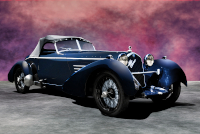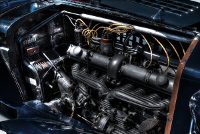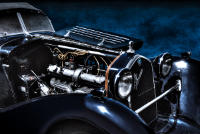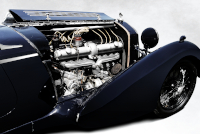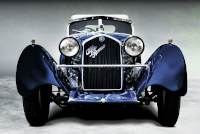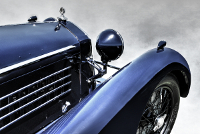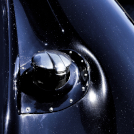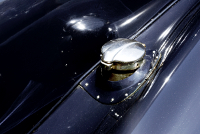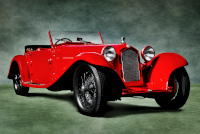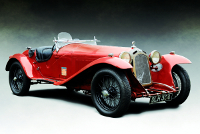Location:
Elegance at Hershey, 2014
Owner: Roger Willbanks | Denver, Colorado
Prologue:
A multicultural tangent, chassis #2311237 became significant not for its factory specification or racing pedigree, but for the unique circumstance of the alterations first granted to it and the restoration then denied to it. Wearing English coachwork placed on the chassis in period, the car passed to Ms. Angela Cherrett in 1964 still locked in its London classic era configuration. She saw to it that the car remained that way. So the Eagle Speedster is a truly unique time capsule.
Chassis #2311237 has been photographed by other sources on a few noteworthy occasions, as in the course of taking top honors at the Concours d'Elegance of America. A nicely patina'd motorcar, the problem I face is that hard sunlight on an old sensor washes out detail.
Continually revising the main image, this profile now uses the fourth published version, an attempt to retain some of the patina while working within a fictional environment. At least the motor images always worked a bit better, so brightly sunlit. But on the surface, the patina becomes washed over by reflection and glare. And so it is ironic that preserving originality is just as difficult in illustration as it is in life.
- - - - - - - - - -
► Image Source: Nikon D200 (10.2 MP)
References:
- RM Sotheby's: The 2024 Monterey auction listing for chassis #2311237, offering good information and a wealth of images.
- Hemmings: "Duesenberg, Alfa Romeo take top honors at the Concours d'Elegance of America" by Kurt Ernst, April 1, 2013.
- FCA Heritage: "Angela Cherrett, an Alfa Romeo Lady" by the stewards of the Museo Storico collection. The purveyors of all things Alfa Romeo provide this article on Angela Cherrett, interviewed alongside her 6C 1500.
Chassis #2311237 began life with a Castagna body of drophead coupe configuration. The style would have appeared quite docile compared to the 8C 2300 MM Spider by Castagna in our portfolio, which is an aberration of Castagna coachwork, and would have rather appeared similar to a Figoni Cabriolet. In any case, the car left Italy with its Castgana coachwork and took up residence with London-based concessionaire Jack Barclay.
Barclay commissioned a sportier configuration, executed in alloy by the nominal Eagle Coach Works, which RM define as, "Newns Coach Builders and Engineers of Thames Ditton, Surrey, a firm which worked primarily under the trade name of Eagle Coach Works Ltd."
RM also note that Alfa Romeo had declared chassis #2311236 and #2311237 as broken up, or scrapped, prior to export, so as to avoid paying duties on the products. Of course the factory sent both chassis to Jack Barclay.
Following its reconfiguration, the English sportsman Roy Gibson took ownership of #2311237; he ran and raced the car until World War II. Surviving into the post-War period, #2311237 has not been restored at any point, remaining preserved since the day it received its English coachwork.
Angela Cherrett and the Value of Originality
Perhaps the reason this 8C 2300 retains its beautiful original condition, in 1964 Ms. Angela Cherrett purchased the car. Cherrett's name appears alongside Simon Moore's among those who laid the foundation for Alfa Romeo history in the English-speaking world. She published two noteworthy volumes, one focusing on the 8C 2300, and one covering the 6C 1500, 1750, and 1900. Cherrett and her husband Allan owned, restored, and drove interesting classic era cars, though Alfa Romeo were her favorite. Her first Alfa was an unusual long-chassis 6C 1500 Sport with three-place Zagato coachwork.
With Angela and Allan's sense of practicality, supported by their interest in history, vintage cars seemed to them as artefacts. They restored and kept cars in good operating condition, enjoying them for their intrinsic value without opining for a high-gloss finish. Fred Simeone shared the same sentiment, and liked for those cars that could be kept as original to show their history.
After roughly 45 years, Angela Cherrett sold chassis #2311237 to Mr. Willbanks, who has kept the car as is. So much is the difficulty of producing a decent illustration of this unique speedster under hostile lighting conditions. I cannot reliably show the patina because the alloy is cloaked in reflections and glare. After four attempts to draw a passable representation, I will need to be lucky and take new stock on new equipment in the unlikely event we see this car again.
Motor: 2,336 cc straight 8-cylinder, alloy block, aluminum hemi-head | 65 mm x 88 mm | 6.6:1 compression | motor #2311237
Valvetrain: DOHC, 2 valves per cylinder, gear-driven via a central mechanism between each 4-cylinder block
Aspiration: Memini twin-choke carburetor, Roots-type supercharger
Power: 155 bhp at 5,000 rpm
Drivetrain: 4-speed gearbox, rear-wheel drive
Front Suspension: beam axle, semi-elliptic leaf springs, friction dampers
Rear Suspension: live axle, semi-elliptic leaf springs, friction dampers
Architecture: pressed steel chassis with aluminum coachwork by Eagle Coachworks of London
Wheelbase: 3,098 mm (121.9 inches)
Etymology:
'8C 2300' refers to the motor configuration, a straight 8-cylinder of about 2.3 litres displacement. The term 'speedster' replaces the more frequent spyder nomenclature, giving a nod to the car's English body by Eagle Coachworks of London.
Figures:
Various internet reports cite that Alfa Romeo built anywhere between 188 and 195 8C 2300 cars; these comprised all manner of racing device—short and long chassis, Monza included. Alfa Romeo built three series, with an additional group provided specially for Scuderia Ferrari. Of all those produced, perhaps this is the only example bodied by Eagle.
Value:
Chassis #2311237 sold at RM Sotheby's 2024 Monterey auction for $4,075,000.
English Tailor: Creating an English Speedster from a Great Italian Racer
An Italian althlete cloaked in an English suit, chassis #2311237 looks British, and yet we should be clear about why it looks so. The body is straight like the 8C 2300 Le Mans, but carries softer, lengthened features in the tail and in both the front and rear skirts. The leading edges of the front skirts are entirely smooth, and yet flop over the front tyres like folded pastry dough. The club tail mimics the curves of many an early Aston, MG, or Squire. The flopsy top would look at home under British Isles drizzle. And the slight cut-down aspect to the door further hints at English roots. Overall, the design is nicely proportioned; it is low and long and, given the long chassis, a rather effective counterpart to an Alvis or Lagonda.
Dulled Bright: Paint and Patina on #2311237
The weathered paintwork bears a stippled finish, and the color appears faded. The stone guard on the rear fender seems dull, but the bare aluminum would probably not have been polished to begin with. Moreover, the finish quality of these smaller pieces lacks the cleanliness of cut that the Milanese coachbuilders would deliver.
For example, the small collar around the filler cap sits within a complicated seam, but it is a patch screwed down like second skin over the internals. Again the workmanship feels less refined than what the Milanese would expect. But today, the level of finish works—imperfect and yet clean, simple where it needs to be in order to highlight the car's mix of personalities. If the car were restored, then that complicated mix might be lost.
Motor Bay: Impression of the 8C 2300 Motor
What impresses is how the 8C motor packs into the long, narrow nose. Particularly looking down the flank, the compressor, steering box, air cleaner, intake manifold, cam cover, and distributor coils appear as if they have been fit in place like a puzzle. These castings would have appeared far more exotic than anything in England at the time.
Last Updated: Mar 26, 2025

